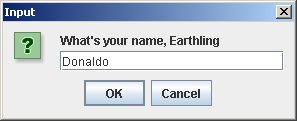Java Notes Prev: Java Example: Dialog: Hello Earthling | Next: Java Example: Dialog: Captitalize
Java Example: Dialog: Take me to your leader
This is similar to the previous program, but it also gets input from the user.
1 2 3 4 5 6 7 8 9 10 11 12 13 14 15 16 |
// Description: This program gets a string from a dialog box, prints message.
// File : examples/introductory/dialog/ToLeader.java
// Author: Fred Swartz - 2006-December-03 - Placed in public domain.
import javax.swing.*;
public class ToLeader {
public static void main(String[] args) {
String name; // A local variable to hold the name.
name = JOptionPane.showInputDialog(null, "What's your name, Earthling");
JOptionPane.showMessageDialog(null, "Take me to your leader, " + name);
}
}
|
- Line 11 - Declaring a local variable.
- This tells the compiler to reserve some memory to hold a String. It's going to hold a name, so we called the variable (a place in the computer's memory) "name". The syntax for a simple declaration is to write the type of thing that a variable will hold (String in this case), followed by the variable name (name in this case).
- Line 13 - Asking the user for a String.

JOptionPane'sshowInputDialogmethod displays a message in a dialog box that also accepts user input. It returns a string that can be stored into a variable.This is an assignment statement. The part to the right of the "=" must produce a value, and this value is then stored in the variable on the left (name).
- Line 15 - Putting two strings together (concatenation)
Concantenation, indicated by the plus sign (+), puts two strings together to build a bigger string, which is then passed as a parameter. The plus sign (+) is also used for addition of numbers. 
Console version
See Java Example: Console: Take me to your leader for how this program would be written using console output.